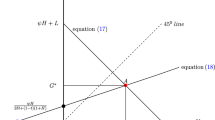Abstract
This paper presents a model in which the composition and size of public spending are determined through a political process. Agents differ in wage rates, and live in households positively sorted by wage; household production benefits both partners but the partners interact non-cooperatively, hence the laissez-faire equilibrium is inefficient. There are three policy tools, a labour income tax rate, a cash transfer and an in-kind transfer. The latter can be combined with household production to generate a household public good. All agents agree on some form of public intervention to remedy the inefficiency, but low-wagers prefer high taxes and cash transfers, while high-wagers prefer low taxes and in-kind provision. Under the empirically plausible assumption that voting participation is positively correlated with income, the equilibrium policy will be of the sort preferred by voters with above-mean income. This effect is accentuated by increased inequality.
Similar content being viewed by others
References
Anderberg D, Balestrino A (2003) Self-enforcing intergenerational transfers and the provision of education. Economica 70:55–71
Anderberg D, Balestrino A (2006) Public spending with non-cooperative families. In: Cigno A, Pestieau P, Rees R (eds) Taxation and the family. CESifo/MIT Press, forthcoming
Apps P, Rees R (1988) Taxation and the household. J Public Econ 35:355–369
Apps P, Rees R (1999) On the taxation of trade within and between households. J Public Econ 73:241–263
Balestrino A (2000) Mixed tax systems and the public provision of private goods. Inter Tax Public Finance 7:463–478
Becker G (1965) A theory of the allocation of time. Econ J 75:493–508
Benabou R (2000) Unequal societies: income distribution and the social contract. Am Econ Rev 90:96–129
Bergstrom T, Blume L, Varian H (1986) On the private provision of public goods. J Public Econ 29:25–49
Bergstrom T, Blume L, Varian H (1992) Uniqueness of Nash equilibrium in the private provision of public goods. J Public Econ 49:391–392
Browning M, Chiappori PA (1998) Efficient intra-household allocations: a general characterization and empirical tests. Econometrica 66:1241–1278
Chen Z, Woolley F (2001) A Cournot–Nash model of family decision making. Econ J 111:722–748
Chiappori PA (1988) Rational household labor supply. Econometrica 56:63–90
Chiappori PA (1992) Collective labour supply and welfare. J Polit Econ 100:437–467
Cigno A (1993) Intergenerational transfers without altruism. Euro J Polit Econ 9:505–518
Epple D, Romano R (1996a) Ends against the middle: determining public service provision when there are private alternatives. J Public Econ 62:297–325
Epple D, Romano R (1996b) Public provision of private goods. J Polit Econ 104:57–84
Fernandez R, Rogerson R (1999) Education finance reform and investment in human capital: Lessons from California. J Public Econ 74:327–350
Fiske A (1991). The cultural relativity of selfish individualism. In: Clark M (eds). Prosocial behavior. Sage, Beverly Hills, pp. 176–214
Friedberg L (1998) Did unilateral divorce raise divorce rates? Evidence from panel data. Am Econ Rev 88:608–627
Gans JS, Smart M (1996) Majority voting with single-crossing preferences. J Public Econ 59:219–237
Glomm G, Ravikumar B (2003) Public education and income inequality. Euro J Polit Econ 19:289–300
Greene KV, Nikolaev O (1999) Voter participation and the redistributive state. Public Choice 98:213–226
Gronau R (1977) Leisure, home-production and work: the theory of the allocation of time revisited. J Polit Econ 85:1099–1123
Gruber J (2000) Is making divorce easier bad for children? The long run implications of unilateral divorce. NBER Working Paper No. 7968
Jargowsky P (1996) Take the money and run: economic segregation in US metropolitan areas. Am Sociol Rev 61:984–998
Konrad K, Lommerud K-E (1995) Family policy with non-cooperative families. Scand J Econ 97:581–601
Konrad K, Lommerud K-E (2000) The bargaining family revisited. Can J Econ 33:471–487
Ledyard J (1984) The pure theory of large two-candidates elections. Public Choice 44:7–41
Manser M, Brown M (1980) Marriage and household decision-making: a bargaining analysis. Int Econ Rev 21:31–44
Mare R (1991) Five decades of educational assortative mating. Am Sociol Rev 56:15–32
McElroy M, Horney M (1981) Nash bargained household decision-making. Int Econ Rev 22:333–349
Thompson S, Pitts J (1992). In sickness and in health: chronic illness, marriage and spousal caregiving. In: Spacaman S, Oskamm S (eds). Helping and being helped: naturalistic studies. Sage, Beverly Hills, pp. 115–151
Vermeulen F (2002) Collective household models: principles and main results. J Econ Surv 16:533–564
Author information
Authors and Affiliations
Corresponding author
Additional information
A previous version of this paper has been presented at the 2004 EPCS conference in Berlin; we thank our discussant Stanley Winer, as well as two referees of this journal, for insightful comments
Rights and permissions
About this article
Cite this article
Anderberg, D., Balestrino, A. Non-cooperative Households and the Size and Composition of Public Expenditure. Economics of Governance 8, 61–81 (2007). https://doi.org/10.1007/s10101-006-0016-x
Received:
Accepted:
Published:
Issue Date:
DOI: https://doi.org/10.1007/s10101-006-0016-x




